Agricultural survey: results - December 2020
Annual agricultural survey results based on data from larger agricultural holdings together with estimates for smaller farms.
December 2020 Agricultural Survey
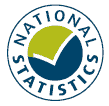
A National Statistics Publication for Scotland
Introduction
The area of winter planted crops recovered after heavy rainfall in 2019. However, the production of silage and haylage fell over the past year.
An increase in the number of calves saw cattle numbers remain stable, steadying a longer term decline. Sheep numbers remained steady with pig numbers increasing for the first time in 3 years.
Reduced capacity in abattoirs and falling demand due to COVID-19 restrictions may have led to higher numbers of livestock remaining on farms later in the year.
The average rent for agricultural land remains stable in real terms. Rents tend to be highest in the east due to better quality land.
Commonly used terms
Hectares (ha): the official measurement of agricultural land. One hectare is 10,000m² or roughly the same size as a full-size rugby pitch.
Ten-year average: this publication compares current values to values over the past ten years. This provides a valuable comparison to previous years and helps set the latest figures in a wider context.
Graphs in this publication show selected categories
Area of winter crops recovers after rainfall
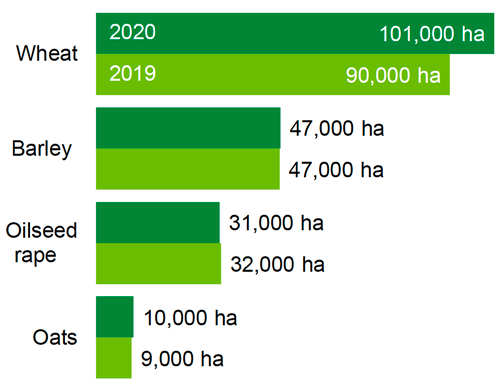
Crops planted in autumn and grown during winter are known as winter-planted crops. The area planted is dependent on weather. For example, heavy rainfall negatively impacts the area sown. The remaining area is generally planted in spring.
Area used to grow winter crops: 189,000 hectares
The area used to grow winter-planted crops increased by seven per cent compared to the previous year. With areas recovering after poor weather in 2019.
Wheat and oats saw the largest increase. The area used to grow wheat has gone up by 12 per cent and oats by six per cent. Oilseed rape was the only crop that decreased in area, by one per cent.
Decrease in animal feed production
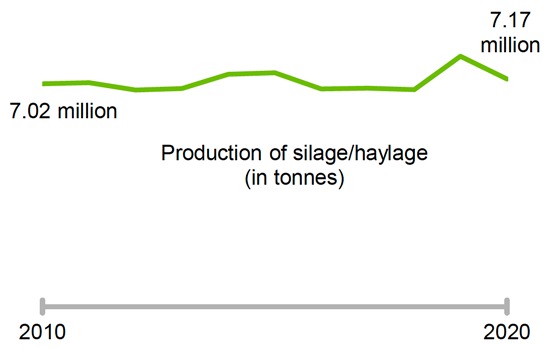
Grass silage is grass cut in the summer which is fermented and has a high moisture content. It is used as animal feed in the winter.
Haylage is grass cut in the summer which has a low moisture content. It is mostly used to feed horses.
Hay is grass which has been cut and left to dry, after which it is stored. It is used as animal feed.
Production of grass silage or haylage: 7.17 million tonnes
The amount of animal feed produced in 2020 was down compared to 2019. A smaller planting area led to a nine per cent fall in the amount of silage and haylage produced over the past year. The amount produced remains higher than the ten year average.
The decrease in production was partially due to a decrease in yield. On average, farmers produced 22 tonnes of silage or haylage per hectare, a decrease of two per cent. The total area used for silage and haylage reduced by seven per cent.
The production of hay also decreased by 22 per cent. Production of hay is now 12 per cent below the ten- year average.
Increase in calves steadies long term cattle decline
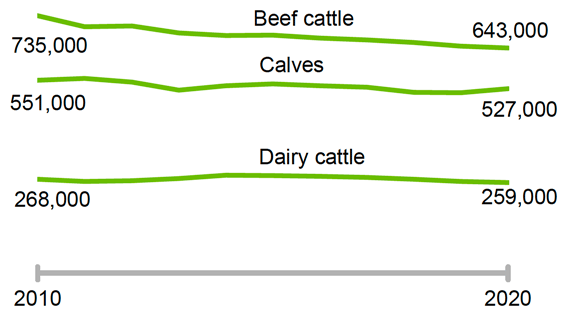
By law all cattle in Scotland must be registered onto the UK Government's 'Cattle Tracing System'. Each animal has a unique tracking number shown on an ear tag. The cattle numbers shown in this publication are taken from the Cattle Tracing System.
Number of cattle in Scotland: 1.63 million
Cattle numbers remain steady when compared to the previous year but are five per cent lower than the ten- year average. In December 2020, the total number of cattle was 1.63 million.
Both the dairy and beef cattle herd size declined by one per cent. Male cattle numbers declined by two per cent. The number of calves increased by two per cent to 527,000.
The long term decline in cattle numbers is likely to be related to a number of financial factors that have led to a decrease in their profitability.
Sheep numbers remain steady
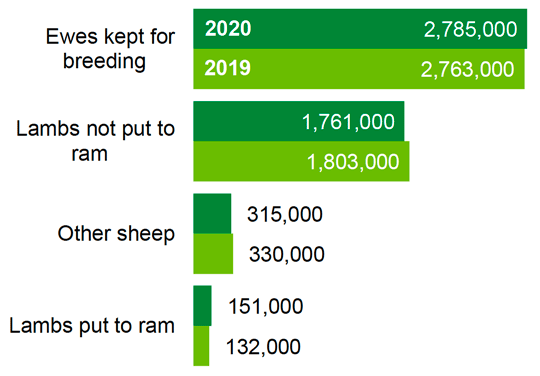
Sheep have lambs once per year, during springtime. The number of lambs on farms declines from spring to winter time as lambs are sold for slaughter. This means that lamb numbers recorded in the December Survey are lower than reported in the June Agricultural Census.
Number of sheep in Scotland: 5.01 million
The number of sheep has remained constant over the past year, at just over 5 million. The total number of lambs fell by one per cent compared to December 2019.
Sheep numbers are 3 per cent above the ten-year average of 4.89 million.
The number of goats increased by eight per cent over the past year to 5,800. This is the highest amount since data collection started in 2015.
Number of poultry in Scotland: 14.43 million
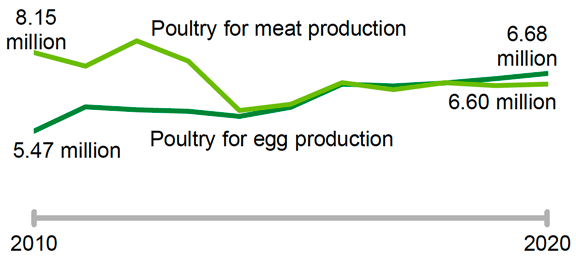
In December 2020, there was a three per cent decrease in poultry compared to the previous year. This was driven by an decrease in both the number of poultry birds for egg production and fowls for breeding.
The number of poultry birds for meat production increased by one per cent.
Number of pigs in Scotland: 356,000
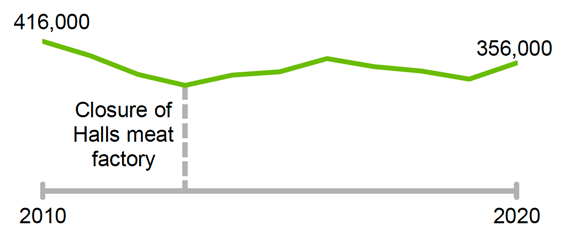
Pig numbers increased by 15 per cent in 2020 compared to the previous year. This is the first increase in pig numbers after three years of decline from 2017 to 2019.
Pig numbers may have been affected by reduced capacity in pig processing plants due to the Covid-19 pandemic, which may have led to more pigs being kept on farm this year.
Agricultural rents fall slightly in real terms
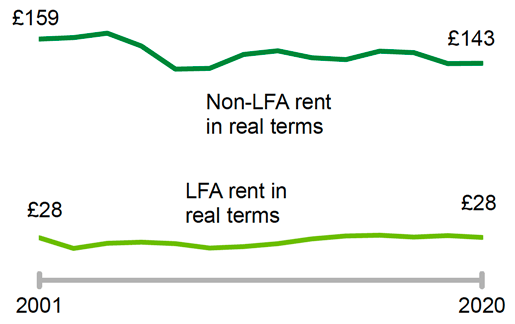
"Less Favoured Area" (LFA) is land which has a natural disadvantage that makes agricultural production difficult. Over 5.73 million hectares of farmland (85%) is LFA land.
A "real terms" value is a value that has been adjusted for inflation. Inflation is the rate of increase in prices for goods and services from one year to the next.
Average annual rent for agricultural land: £42 per ha
Average rents have increased slightly to £42 per hectare. Farmers pay more rent for better quality land. In 2020, the average rent for non-LFA land was £143 per hectare. In real terms, this is the same as it was in 2019. In areas with poorer quality land, rents tend to be lower. The average rent for LFA land was £28 per hectare, down four per cent in real terms from 2019.
Average real terms rents have fallen from £159 to £143 per hectare for non-LFA farms since 2001. For LFA land, rents have stayed the same.
Farm types which can operate on LFA land, such as cattle and sheep farms, generally have smaller rents. Cereal farms, which require good quality land, have larger rents.
Eastern areas have the highest agricultural rents
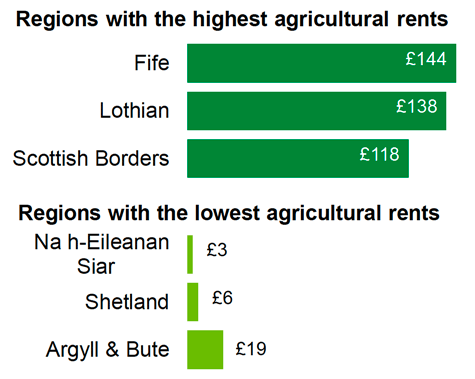
The median is a measure of average that identifies the middle value, where half the rents are higher and half the rents are lower. It is a better measure of the "typical" average rental value than the mean as it not impacted by extremely high or low rents.
Rents calculated from very low sample sizes (less than five holdings) have been excluded from the graph.
Median rents in Fife: £144 per ha
Median rents vary across the country, mostly due to quality of land and accessibility of the area. Rents are generally higher in eastern areas, where the majority of cereal farms are located, and southern areas, containing the majority of dairy farms.
Areas with the lowest agricultural rents include Na h- Eileanan Siar, Shetland and Argyll & Bute. These areas contain mainly LFA land, used for rough grazing for sheep.
Slight decrease in machinery levels on farms
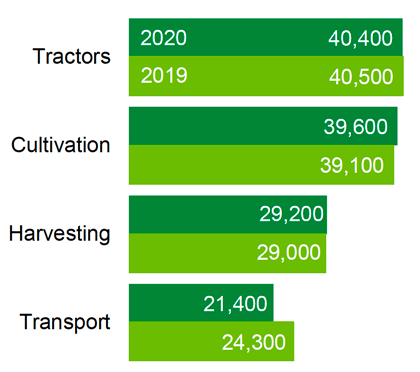
Information on machinery is only collected for larger farms. Data on equipment such as field crop or fruit sprayers, drainage and ditching equipment, milking parlours and cattle weighing crushes are also collected.
Wheeled Tractors: 40,400
There was a small decrease in machinery levels on farms. The numbers of tractors and machinery for cultivation remained stable, except combine harvesters which decreased by six per cent.
Machinery for harvesting remained stable, and transport decreased by 12 per cent.
Over the last five years, whilst the total number of wheeled tractors on farms has remained relatively stable, there has been an increase in the number of more powerful tractors at the expense of mid-engine machines.
Data sources and more information
Data source
This data is collected via an annual December Survey run by the Rural and Environmental Science & Analytical Services Division of the Scottish Government. The December Survey collects various data from agricultural holdings across Scotland. Sheep data are also collected during the annual sheep and goat inventory.
A full quality assurance and methodology report can be found accompanying this report.
Contact : Scott Mcfarlane
Contact Email: agric.stats@gov.scot
Data tables
A full set of data tables for this publication is available online in the accompanying spreadsheet.
Crown Copyright
You may use or re-use this information (not including logos) free of charge in any format or medium, under the terms of the Open Government Licence.
Comparisons
Similar surveys take place each year in England, Wales and Northern Ireland. Full results for the United Kingdom are available online.
December 2021 Agricutural Survey
Contact
Email: agric.stats@gov.scot
There is a problem
Thanks for your feedback